

With my sojourn in New Mexico complete, I was beginning the long drive back home eastwards by passing through more states that I had never visited before. The next stop on my trip would take place in Oklahoma, and specifically in the capital of Oklahoma City. This state is defined by its large Native American population, its traditional reliance on oil and natural gas for its economy, and the Broadway musical Oklahoma! created by Rodgers and Hammerstein. Nicknamed the "Sooner State" after the settlers who illegally came here in the late 19th century, Oklahoma has its own unique combination of local factors that distinguish it from the larger and better-known neighboring state of Texas to the south. Oklahoma was another one of those places where I couldn't find much tourist information in books or online, but I had no difficulty filling up my time with places to see and activities to do.

Before I could visit Oklahoma, however, first I had to reach the state. The western half of the United States has a lot of empty space between destinations, and it was a long drive from my previous stopping point near Carlsbad Caverns to reach Oklahoma City. When I mapped out this leg of the journey ahead of time, I saw that it was going to take about 8 hours of driving to cover the 500 miles / 800 kilometers to Oklahoma City. That looked like a full day's worth of travel time, and I realized that I would need to stay two nights in Oklahoma City since I wouldn't have time to see much of anything the first day. This was the only place where I spent two nights in the same place on this vacation, as I otherwise went to sleep in a different city each night. I decided to make the most of this travel day by bookending two small destinations at either end of the long drive, first visiting Roswell, New Mexico as detailed on the previous page, and then stopping in Norman, Oklahoma to see the University of Oklahoma at the other end.
In between, I spent most of this day driving through eastern New Mexico, the Texas panhandle, and then western Oklahoma. This portion of the USA is sparsely populated and I saw little of interest on the trip. The first half of the journey took place on local state roads, Route 70 in New Mexico and then Route 60 in Texas, which mostly ran arrow-straight through the dry prarie terrain. The railroad tracks ran parallel to the road and at a couple points I spotted trains moving in the opposite direction. That was the liveliest part of this trip, as there was little else to be seen along the way. I had researched Amarillo, Texas to see if there was anything interesting to see there as I drove through, and one of the top results that came back was the American Quarter Horse Hall of Fame. No offense, but I could pass on that one. Afterwards, it was a long drive on Interstate highway 40 until I reached the suburbs of Oklahoma City, where more attractions began to come into view.

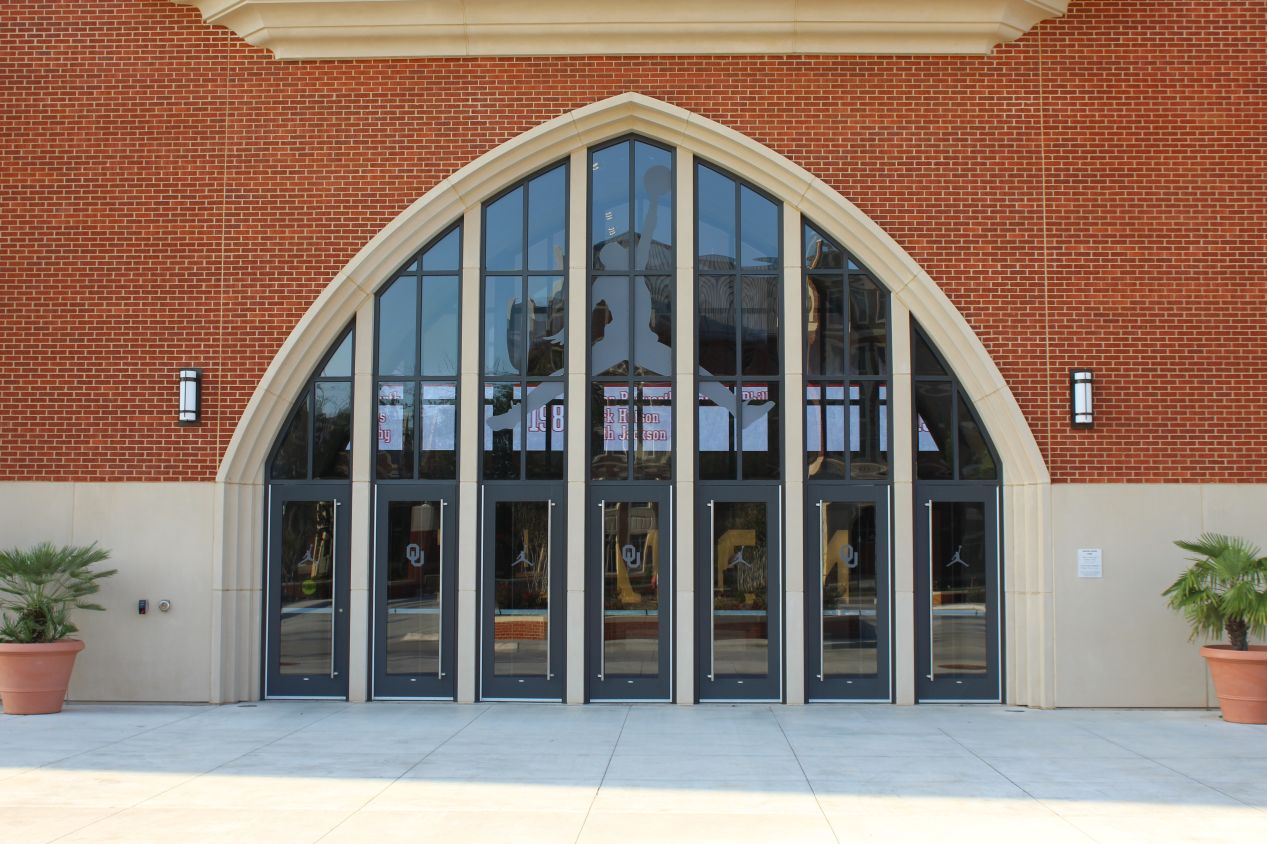


The University of Oklahoma is located in the town of Norman about 20 miles / 30 kilometers to the south of Oklahoma City, normally reachable in about half an hour. I parked on the south side of campus and it turned out to be right next to the football stadium. The official name for this place is the Gaylord Family Oklahoma Memorial Stadium (hooray for big money donors landing the naming rights) but is more popularly called by its traditional name of Memorial Stadium. The Oklahoma football team has been playing here since 1923, and the stadium has been greatly enlarged over that span of time to reach its current seating capacity of roughly 86,000 people. This is another place where college football is taken very seriously indeed, and Oklahoma has been one of the nation's most successful football programs over its long history. According to their website, Oklahoma football has the most wins and the highest winning percentage of any college in the post-1945 era, which is a somewhat arbitrary starting point but does exclude the weird early years of college football when the Ivy League schools were perennial powerhouses. Oklahoma football has won 7 national championships, 48 conference championships, 7 Heisman Trophies (awarded to the best player in the sport each year), including the last two Heismans at time of writing in 2017 and 2018, and holds the record for the longest winning streak in college football history with 47 consecutive wins from 1953 to 1957. The 2018 Oklahoma team would finish fourth in the country at the end of the year and go on to get crushed by Alabama in the national semifinal. This is a really, really good football program and it showed on the campus with this gigantic stadium, lavish practice facilities, and individual statues commemorating each of the past Heisman Trophy winners who played at Oklahoma. They're going to need to add another one now since quarterback Kyler Murray won the 2018 version of the award.

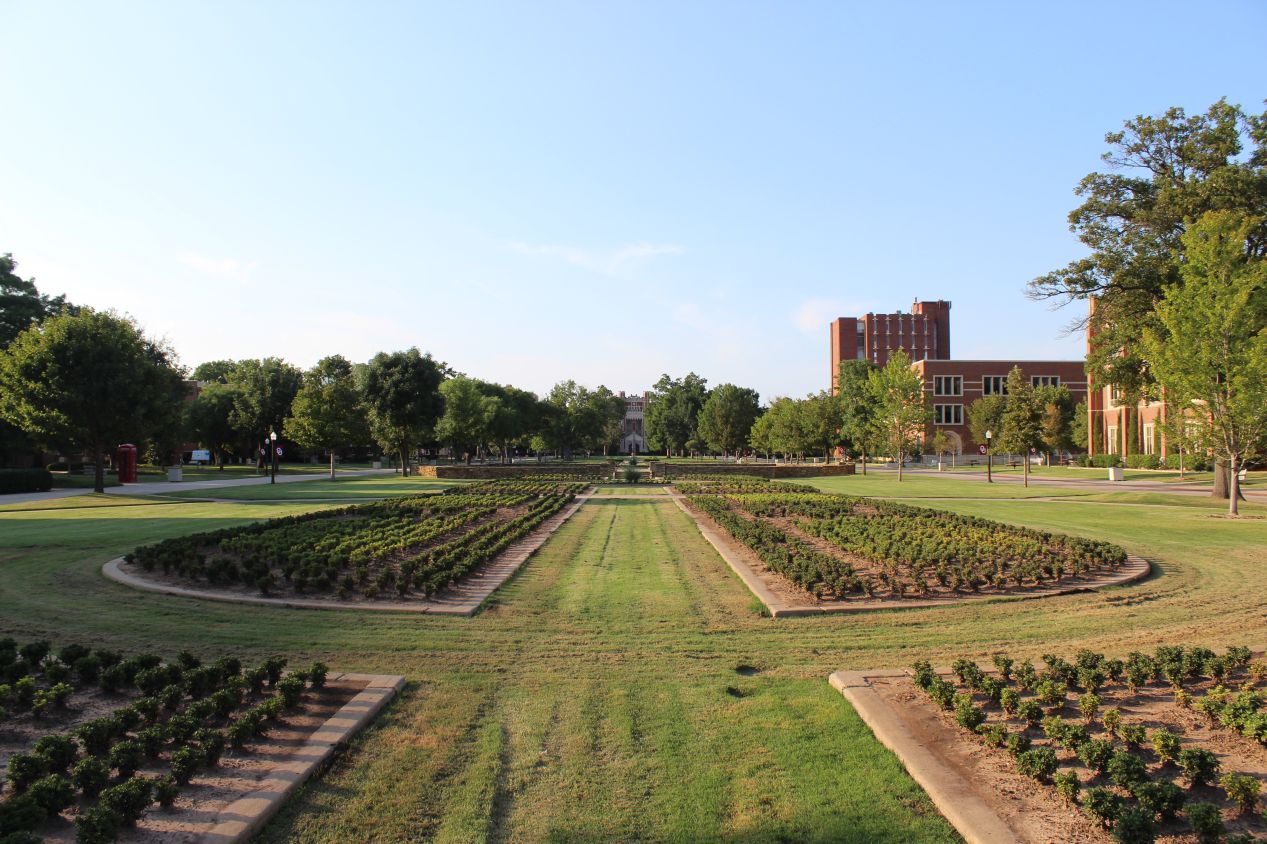


Unlike the situation at many of the colleges that I'd visited, the football stadium at Oklahoma is located right in the middle of the campus and I found myself heading down the nearby main quad next. There was a statue of a Sooner situated at the entrance gates to the university grounds overlooking the green space beyond. "What is a Sooner?" you may be asking; this is the name given to the (white) settlers who entered unassigned territory in what is now the state of Oklahoma before the official start of the Land Rush of 1889. Oklahoma was originally supposed to be set aside as a location for Native Americans tribes and was known as "Indian Territory"; this was the ending point for many of the tribes in the southeastern United States when they were forcibly removed from their lands and sent on the infamous Trail of Tears. But eventually, once the rest of the frontier had been settled, there was a desire to set up farms in the Indian Territory as well, and the "sooners" were the individuals who violated the law and illegally created their own homesteads in what later became Oklahoma (they entered before the law allowed, i.e. they arrived "too soon"). The name originally had a negative connotation but over time became popular and was adopted by both the University of Oklahoma and the wider state as a mascot. It's a neat story for everyone who isn't Native American, as they were conveniently erased from the traditional narrative. Fortunately, things have improved in that regard over time and there's a recognition of the past wrongs inflicted against indigenous peoples. The modern University of Oklahoma has one of the largest Native American student populations in the country, there are a number of statues on campus dedicated to Native Americans from Oklahoma, and it offers language classes in Cherokee, Choctaw, Muscogee Creek, and Kiowa as part of its Native American studies program.

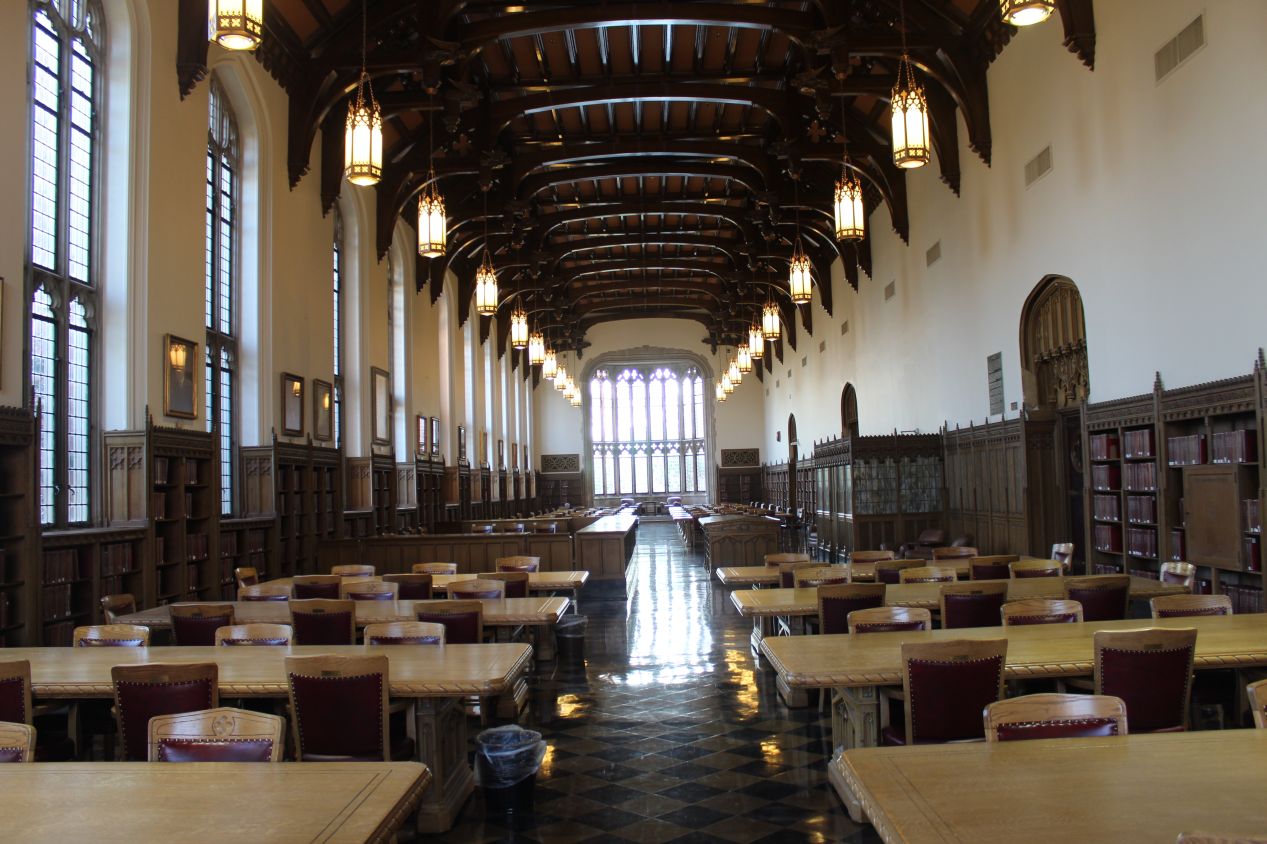


I was impressed by what I saw while walking through the Oklahoma campus. I didn't know much about the university prior to visiting, and I was struck by how beautiful the grounds looked while I was wandering about. Perhaps I was simply visiting at the right time, the "golden hour" as the sun was setting and casting all of the academic buildings in a soft glow, and also visiting during the summer months when everything was quiet and mostly empty. Regardless, Oklahoma was easily one of the prettiest universities that I had visited, and I've been lucky enough to see a lot of them. The campus buldings had a distinctive architectural style known as "Cherokee Gothic", with many of the cathedral-like features of the Gothic era but also mixed with the designs of local Native American tribes from Oklahoma. One of the best such examples was Bizzell Memorial Library, the stately building pictured above. For the most part it looked like a standard Gothic-style building in the tradition of Oxford and Cambridge, but had just enough decorative flair to indicate the Native American elements that inflenced the design. This library was also associated with a famous desegregation court case from the 1950s, when retired black professor George McLaurin was given a desk in the mezzanine of this building, rather than being allowed use of the regular reading room under the "separate but equal doctrine". He successfully sued and won the case when it went to the Supreme Court. In addition to being a beautiful building, Bizzell Memorial Library has therefore also been named a National Historic Landmark due to its role in this court case.

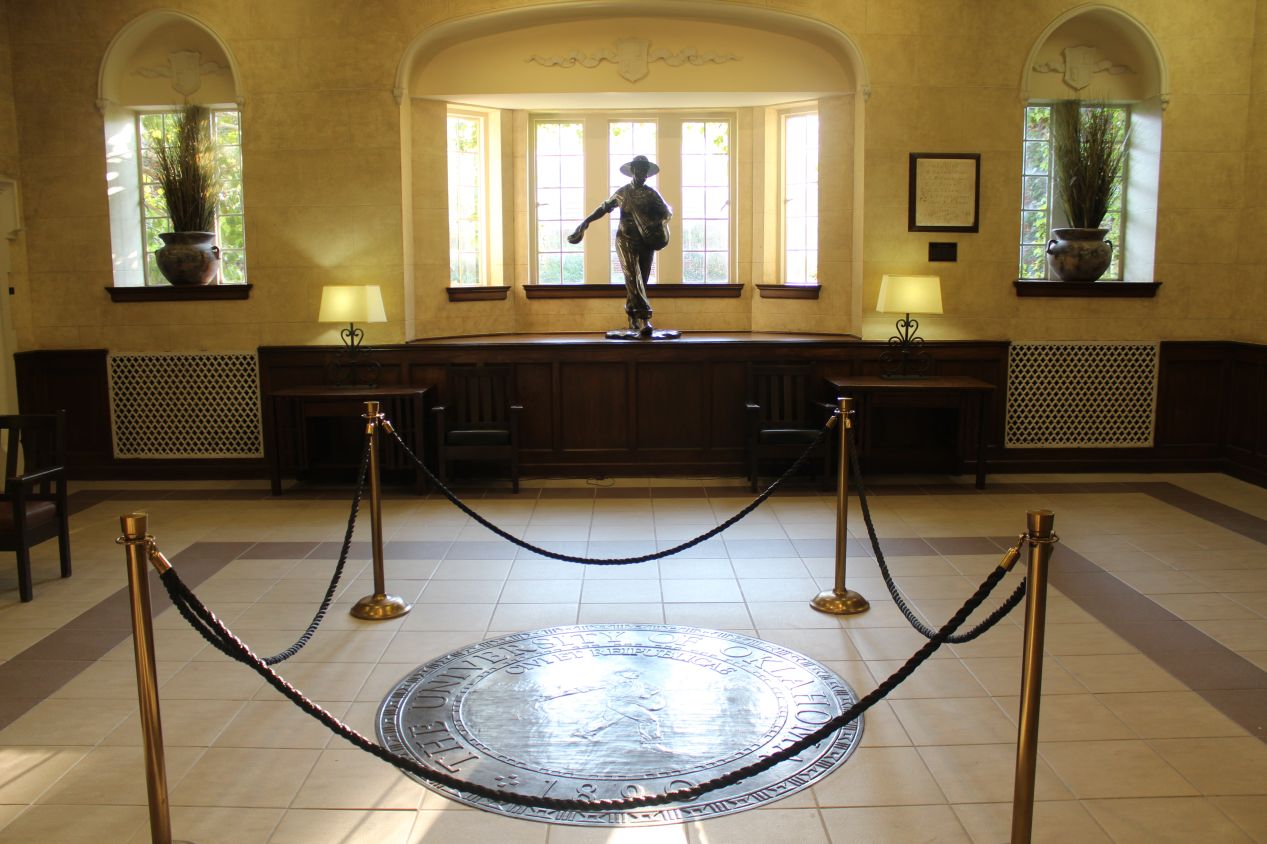


I also took the time to wander through the Oklahoma Memorial Union which was located near the library at the top of the main quad. The official visitor center was closed due to the evening hours, but fortunately this student union was still open for me to see. The upper floors were more formal and contained this swanky-looking lounge area with comfortable couches, bookshelves on the walls, and a full fireplace. The lower floor looked more like a usual student area, with cafeteria-style dining and fast food vendors that were also closed for the night. I spotted an old version of the "Sooner Schooner" at one of the entrances into the union, a full-sized replica of the covered wagons that the sooners used when they came to settle the state in the late 19th century. A newer version of the Sooner Schooner is still brought out at home football games to entertain the crowds, pulled by live horses. While I don't think that's quite as impressive as the live buffalo that I saw at the University of Colorado, it's not half bad.
The University of Oklahoma was the only attraction that visited on that first day of travel. With night beginning to fall, I drove north to Oklahoma City and checked into my hotel for the evening. The next morning, I was actually able to wake up at the normal time of 8:00 AM since I didn't have to spend hours driving to a new city for once. I had the full day available to spend in Oklahoma City, and for once time to visit pretty much everything on my list. The one downside was the fact that Oklahoma City is a widely spaced city in geographic terms; a lot of the things that tourists would be interested in seeing are not located very close to one another. I had to do some planning to work around the fact that most of the places on this page were not within walking distance of one another.

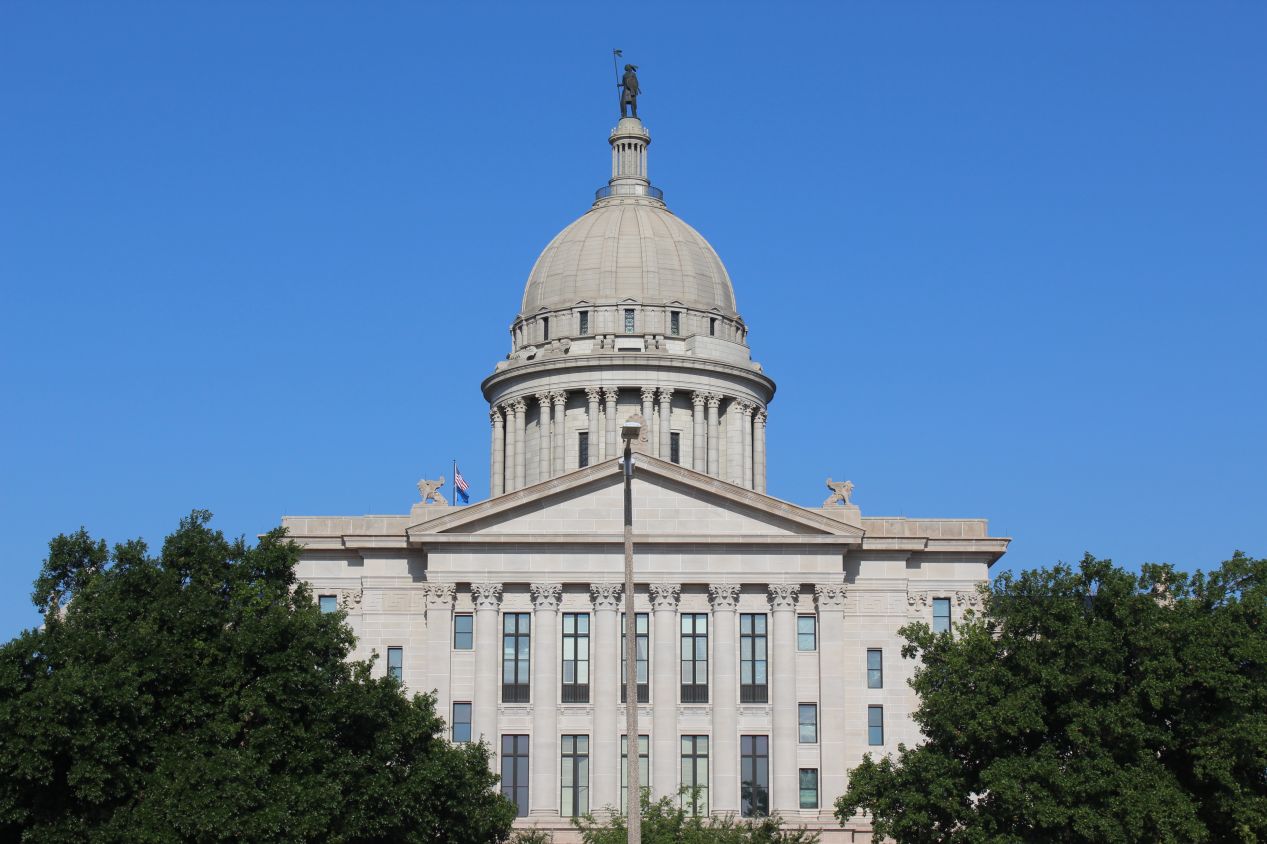


First on my list was the Oklahoma State Capitol, the seat of government for the state. As the name suggests, Oklahoma City serves as both the state's largest city with roughly 650,000 people living in the metropolitan area, and also as the state capital. The current state capitol building was constructed between 1910 and 1917, sharing the same distinctive design elements that I had seen in many other state capitals throughout this trip. The Oklahoma State Capitol had the standard Neoclassical elements with Greek pillars at the entrances, separate wings for the two legislative branches, and a central dome rising up over the middle of the structure. Interestingly, the dome was a relatively recent addition to the building from 2002 which was not included in the initial construction due to lack of sufficient funds. The Oklahoma State Capital is also known for having an active oil rig on its grounds, which I captured in the last picture above. Fossil fuel industries are a major part of the state's economy, and although this is probably going to be a terrible look for the state in a few decades, for the moment there's still widespread local support for the oil industry.

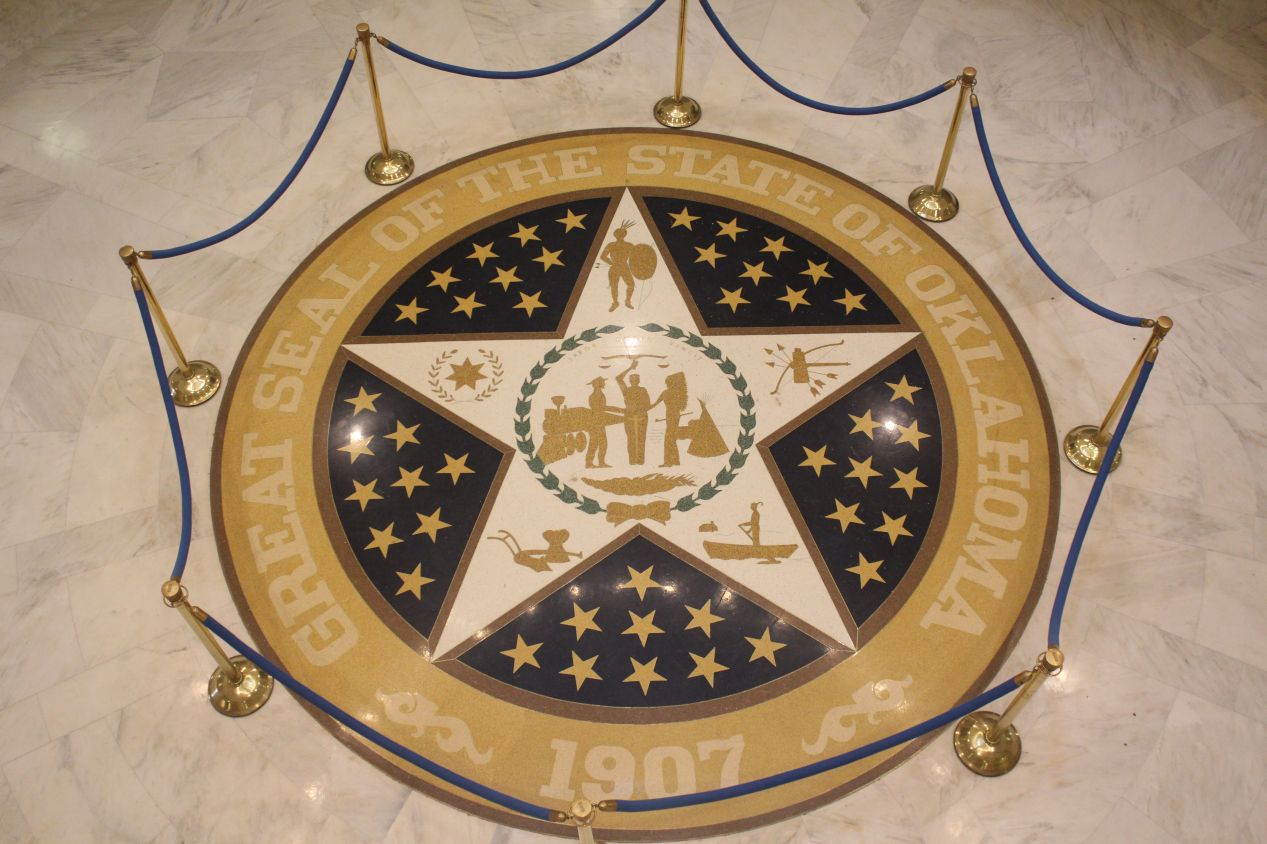


Like the Michigan State Capitol building that I had visited in Lansing, the Oklahoma State Capitol also had significant construction taking place when I arrived, although fortunately the building itself remained open. The whole Senate side of the place was under heavy repairs, with workmen walking around in safety goggles and big plastic sheets strung up to minimize the dust kicked up by the construction. Leaving that area aside, the rest of the building had the usual stately appearance of a state capital, in particular the area around the main dome. The Great Seal of the State of Oklahoma was worked into the floor underneath the dome, and there was an impressive view looking upwards at the underside of the ceiling. Unfortunately, in order to raise money to build the dome, the Oklahoma legislature literally sold off its naming rights to the largest donors, who are memorialized in the "Ring of Honor" that runs around the base of the dome. If you look closely, you can spot the name of Conoco Incorporated and Philips Petroleum Company up there thanks to the sizable sums they contributed. Without getting too political here, I'll just state that I don't think it's a good look for the state to have corporate donors literally carved into the fabric of the state capitol building itself.

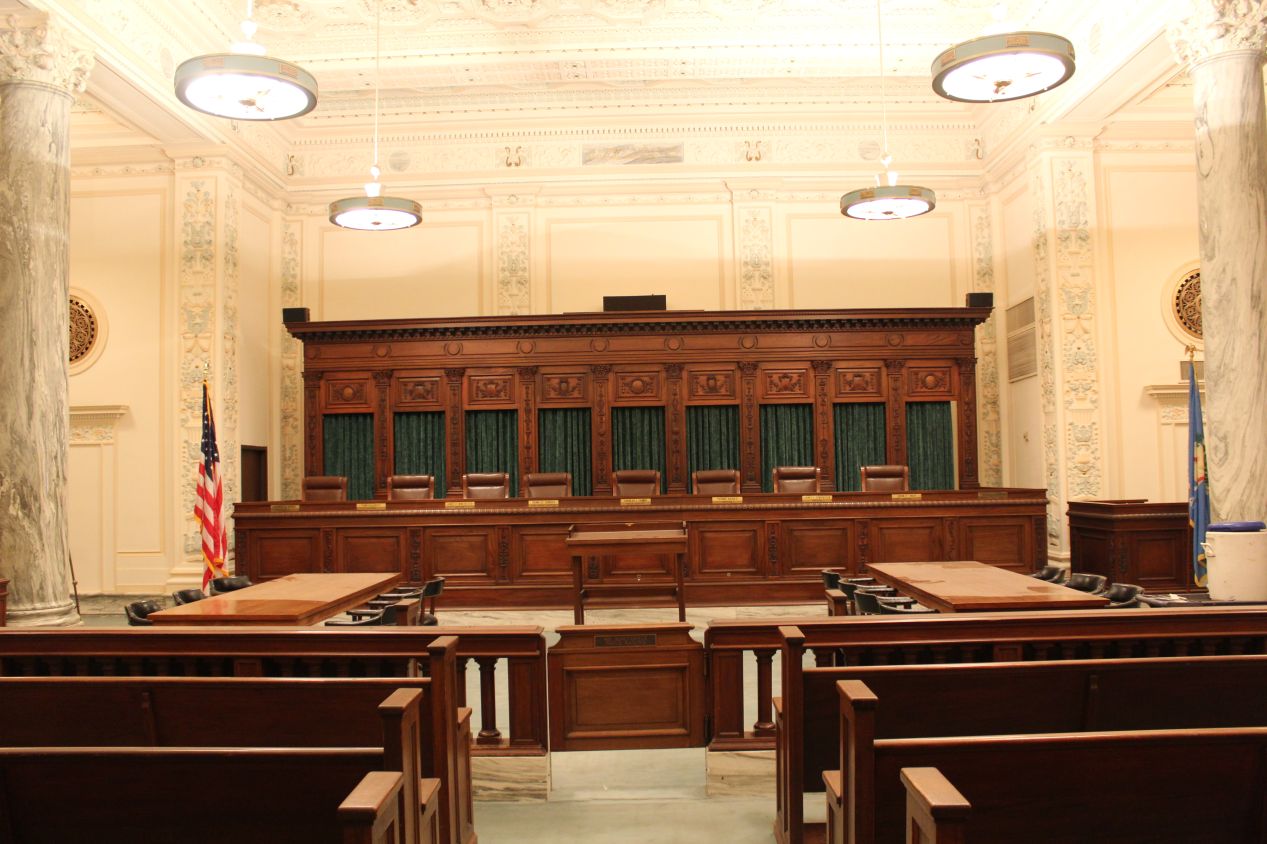


The Oklahoma State Capitol houses the traditional hearing room of the state supreme court, although the actual judicial work of the court takes place in a separate building today. There are nine justices on the Oklahoma Supreme Court, just like the United State Supreme Court, and they are appointed by the governor to serve a six year term, after which they are up for reelection by the state's voters. When I visited in 2018, there were eight seats behind the bench because one of the justice spots was vacant at the time. The Supreme Court room was constructed out of the same white limestone that makes up most of the building, and there was no one else present in the deserted room. This was one of those times where I opened up the door, found it unlocked, and hoped that I wouldn't get in any trouble as I took pictures. Whether it was due to the ongoing construction or a general lack of interest from tourists, there were hardly any people visiting the state capitol building this day.

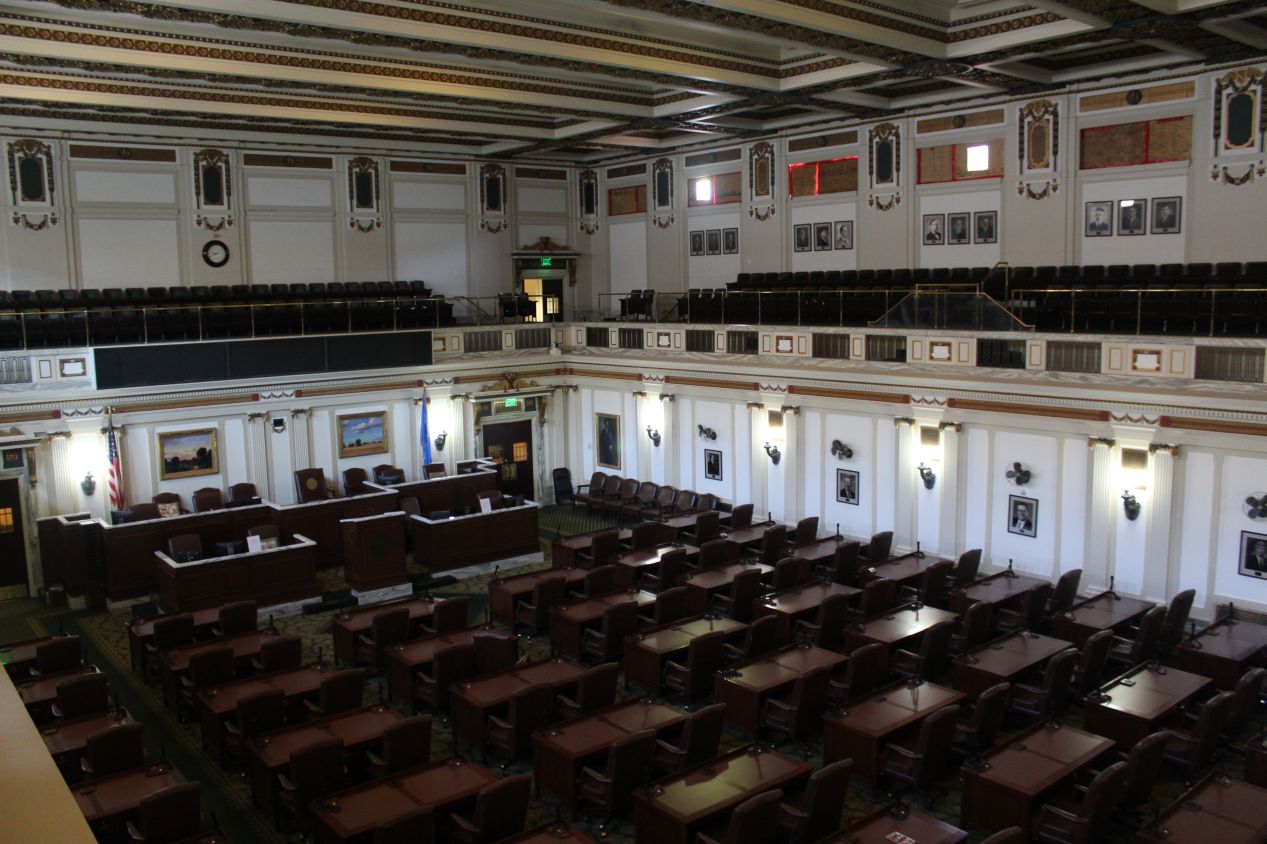


The only one of the legislative chambers open to the public was the Oklahoma House of Representatives, which is where the pictures above were taken. This is the lower of the two houses in the state legislature, with 101 members each serving two year terms. Oklahoma is one of the states that has term limits for its legislators, who can only serve a total of 12 years counting time spent in both the Oklahoma House and the Oklahoma Senate. This is a highly conservative state and at the time of my visit in 2018 the Republican party had a supermajority in both the Oklahoma House and the Oklahoma Senate. The House chamber itself was a bit less grand than in some of the other state capitols that I'd visited, arranged in more linear fashion and without some of the extravagent decorations found in places like the Illinois State Capitol. I was amused by the tiny little desks that the House members shared with one another; I guess there isn't enough room to space them out and give each member their own desk. As for the Oklahoma Senate, I couldn't get in there and was only able to see the Senate Assembly Room used for hearings, which was the smaller and more modern room pictured above. There were some staffers in there using the room when I visited, and I rather uncomfortably snapped a few pictures before sneaking out.

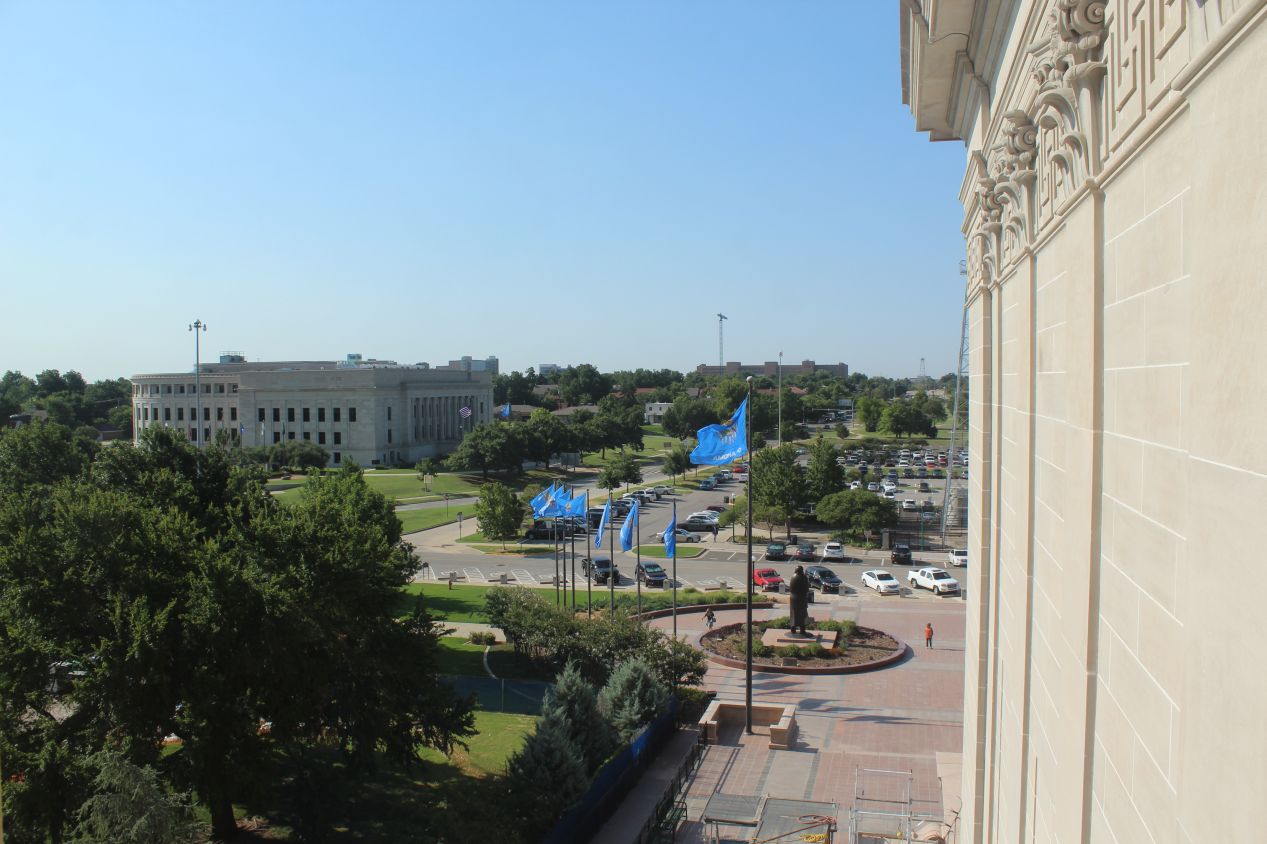


The Governor of Oklahoma also has their office in the state capitol building, although that too was under construction and I couldn't see anything except the exterior door. However, I came across this formal room near the governor's office that appears to be used for press briefings or similar state functions, and that was almost as good. When I walked behind the lecturn, I found that someone had left the text of a bill signed by the governor sitting there, an act that dealt with the appointment and salaries of county election boards. (Most of the bills that get passed at both the state and national level tend to be fairly uninteresting stuff like this.) I did note that the bill was signed by then-current Governor Mary Fallin, who served two terms as governor from 2011 to 2019. Despite winning reelection in 2014, Fallin was toxically unpopular by the end of her term due to allegations of corruption and hypocrisy; an October 2018 poll gave her an approval rating of only 17% and a disapproval rating of 75%, making her the most unpopular governor in the country. It's probably a good thing that she was term-limited out of office and didn't need to run again.

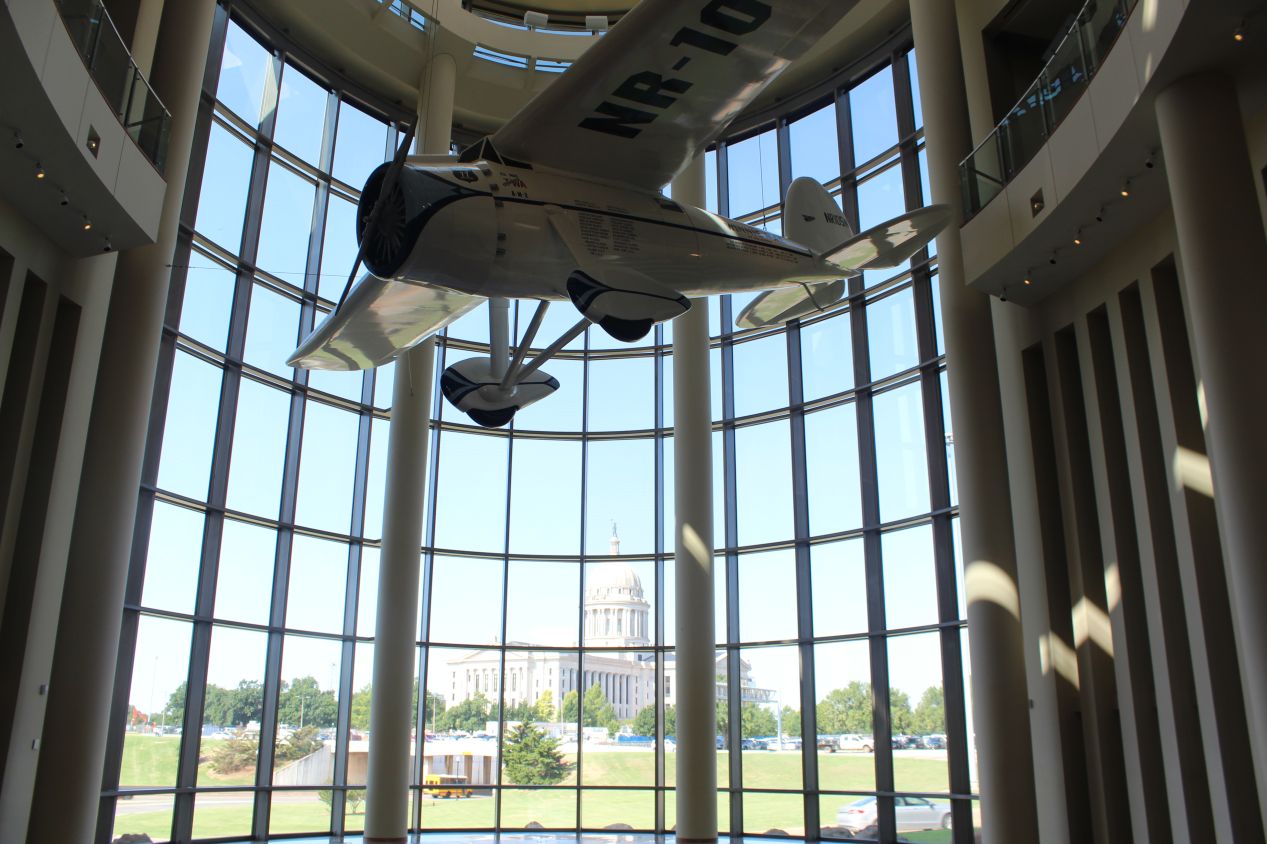


On the other side of the highway from the state capitol was the Oklahoma History Center, the official state museum run by the Oklahoma Historical Society. This museum opened in 2005 and is dedicated to telling the history of Oklahoma from its ancient Native American tribal nations to the present day. The high-ceiling lobby of the museum contains a life-sized replica of the Winnie Mae, a plane flown by aviator Wiley Post during the 1930s. I liked how the museum had set up the plane so that the state capitol was visible in the background when looking through the large windows of the museum. As far as exhibits went, there was a large area on the first floor dedicated to the Native American presence in Oklahoma, for both the original tribes in the state and the many others which were relocated there by the US Army. It did a nice job of distinguishing between these groups and pointing out the differences between the tribes of the Great Plains and those of the Southeast.

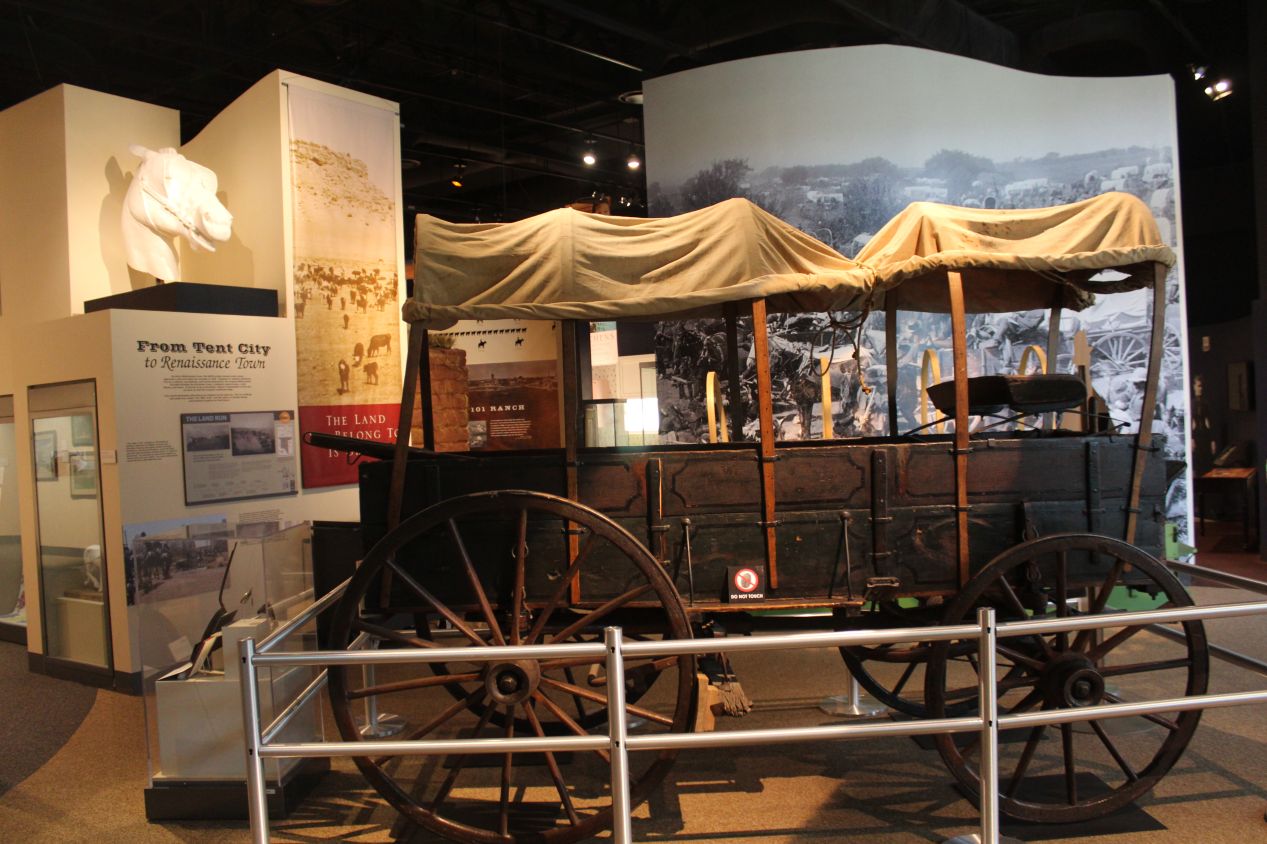


The upper floor of the museum had a series of different exhibits that covered different aspects of life in Oklahoma, from the frontier period up through the modern day. I enjoyed reading about the rampant land speculation of the 1890s, a subject that I didn't know much about previously. This was the "sooner" era where the land set aside for Native American tribes was repeatedly carved up and sold off at auctions, with the Land Run of 1889 being the largest and most famous of these events. The Oklahoma History Center did a reasonably good job of putting this period into context and walking visitors through the effects of these land runs on both the incoming white settlers and the native groups that were being disposessed. Elsewhere, the museum had a separate area devoted to the musical Oklahoma!, which has likely become the single most famous thing associated with the state. Rodgers and Hammerstein had never visited Oklahoma before writing the musical and it blew up into a much bigger success than they had ever expected. Other parts of the museum contained a tribute to Oklahoma military veterans in different wars throughout the nation's history, including a section on some little-known Civil War battles that were fought in the state. And there was even a brief section on Oklahoma sports, featuring the arrival of the Thunder in 2008 as the city's first major professional sports team.


Speaking of museum exhibits found only in Oklahoma, the history center also had this odd section devoted entirely to celebrating oil and gas energy. This was not a museum display that discussed the tradeoffs of resource use as balanced against the environment; it was simply a straight-up celebration of oil and natural gas for energy production, and their importance for the state of Oklahoma. It was the sort of thing that I would have expected to see in 1918 or 1958, not 2018, and felt weirdly out of place in the 21st century. Yes, these natural resources are still critically important and will be for decades to come, but moving away from dependence on them in favor of cleaner sources of energy should be the goal moving forward. Overall, this was a bizarre way to tell the story of a key part of the state's economy. I suspect that there was corporate donor money somewhere behind the scenes that encouraged this particular museum attraction.

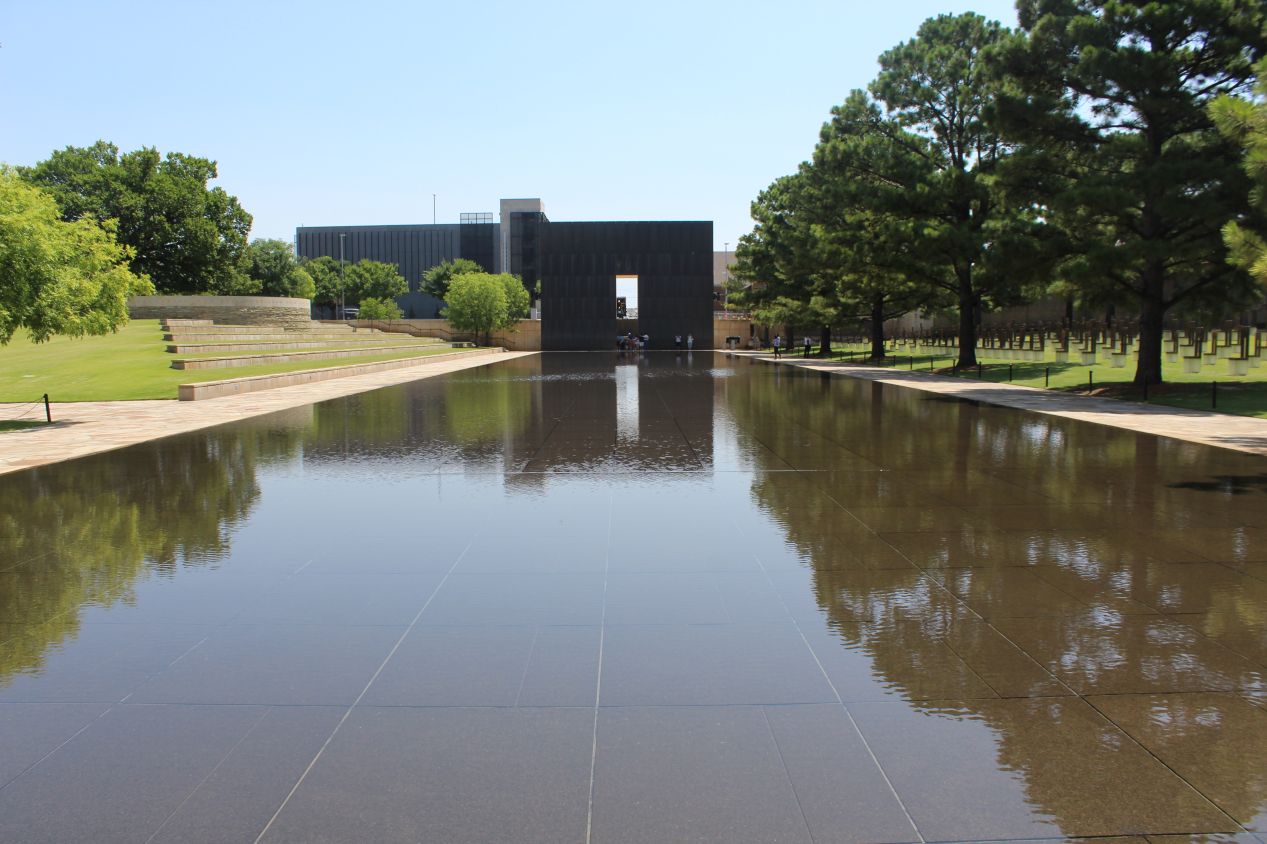


After leaving the Oklahoma History Center, I hopped into my car and drove towards the downtown portion of Oklahoma City. If there's one famous event that I can remember taking place in Oklahoma City, it was the devastating bombing of the Alfred Murrah Federal Building in 1995. I was 12 years old at the time, and I vividly remember seeing the horrible television footage of the truck bomb that completely destroyed the federal building in Oklahoma City and killed 168 people, including two dozen children at a daycare facility in the building. Today the site of the bombing has been transformed into the Oklahoma City National Memorial, a place of quiet reflection in the middle of the otherwise bustling downtown. This was the first place that I wanted to visit in the center of the city.

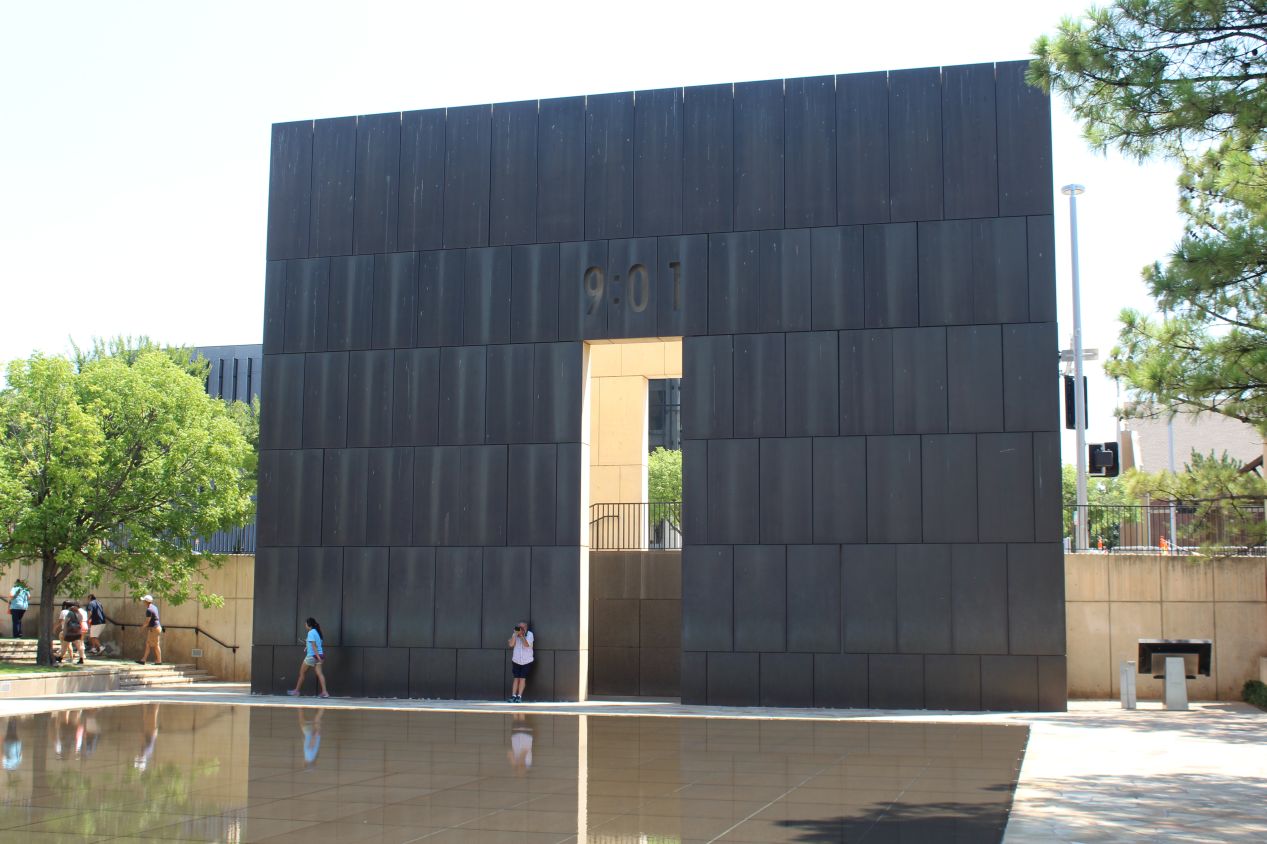


The memorial sits on the same location as the former federal building, and therefore is situated below ground level at the spot where the original building foundations were located. The center of the attraction is a reflecting pool, where a thin layer of water flows over polished black granite. The water is shallow enough that it easily reflects back the image of anyone who looks into it. At either end of the memorial are two bronze gates with time stamps on them, 9:01 AM and 9:03 AM, representing the last minute before the bomb went off at 9:02 AM and the minute that the recovery effort began afterwards. The other major feature of the memorial is known as the Field of Empty Chairs, a series of 168 sculpted chairs to commemorate each of the individuals who died in the bombing. It's always harder to see the victims of a disaster blocked out one at a time individually, and the tiny little chairs for the 19 children who were killed hit me particularly hard. I work in a federal office building every day, and if we have children, we'll likely send them to the daycare facility in my building at some point. If another maniac wanted to target the government, it could be me and my family affected next time. Scary stuff.
This is a truly beautiful memorial and I highly encourage anyone visiting Oklahoma City to go see it. This is the spiritual heart of the city and it was the main reason why I wanted to stop in Oklahoma City on my trip.

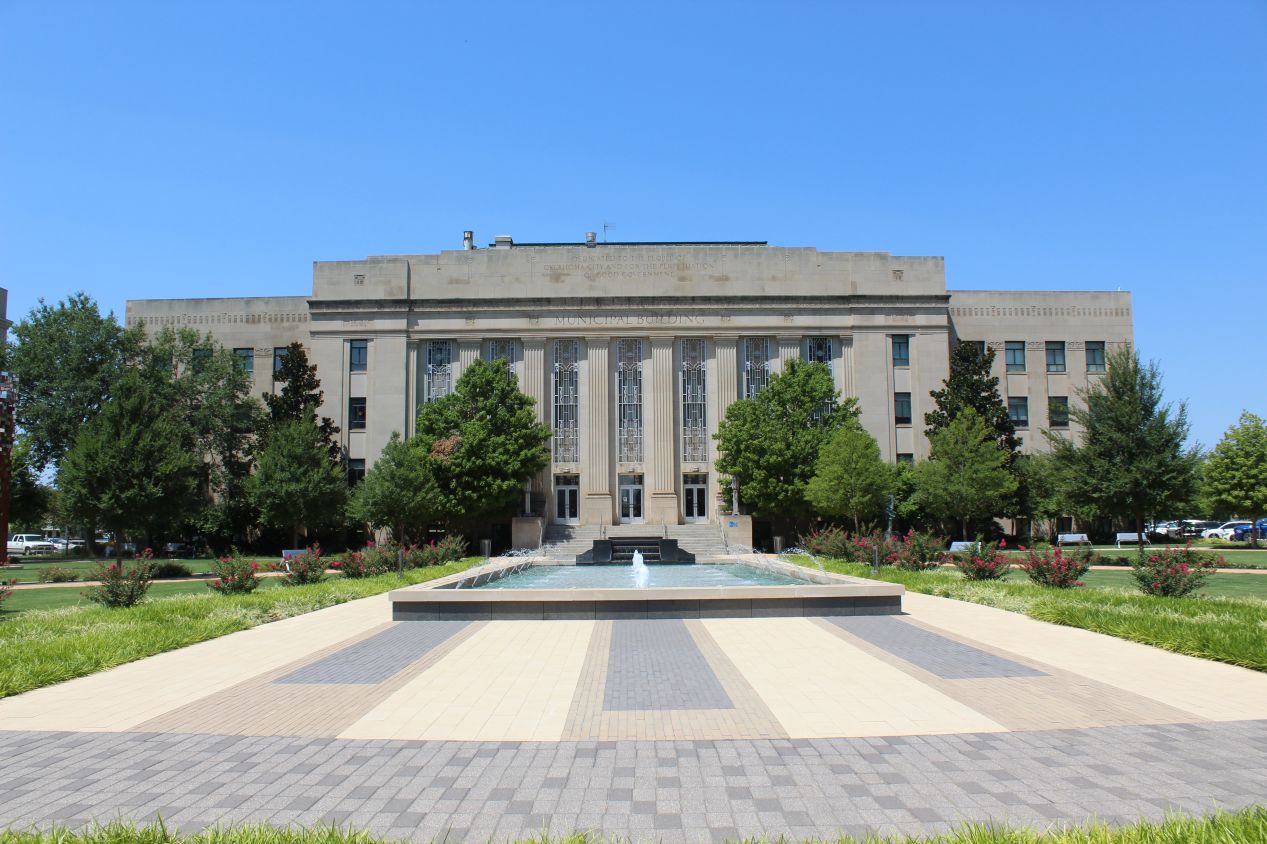


On a less somber note, the Oklahoma City National Memorial is also located just a few blocks north of the downtown business district, and I had an easy walk from there into the center of the city. Oklahoma City has been growing rapidly over the last few decades, and it now ranks as the 27th largest city in the United States. While that might not sound terribly impressive, it means that Oklahoma City ranks higher in metropolitan population than better-known cities like Las Vegas, Baltimore, Milwaukee, Kansas City, and Atlanta (although Atlanta is actually larger and has a weird definition of what comprises its metropolitan area). The growth of the city is reflected in lots of new construction in the business district, particularly the 850 foot / 250 meter Devon Energy Center building constructed in 2012. This gleaming pillar of steel and glass towered above me wherever I went in downtown Oklahoma City; unfortunately it does not have an observation deck, only a restaurant up at the top. In addition to some of the municipal buildings and the city courthouse, I also found a very oddly-shaped structure that looked like a big horizontal glass tube. This was the Myriad Botanical Gardens, with the specific area that I was seeing known as Crystal Bridge. There were lot of kids outside enjoying the sunny weather on this afternoon, playing in the public park that surronded the gardens.


Downtown Oklahoma City is also where the Thunder play their home games at Chesapeake Energy Arena. (Yes, every corporate sponsorship in the city seems to be tied to an energy or natural resources company in some fashion.) When the Seattle Supersonics relocated here in 2008, they became the first major professional sports team to call the city home, and as a result the Thunder are extremely popular in Oklahoma City. I saw signs and jerseys for the Thunder everywhere that I went, and in the decade that the team has called the city home it's become clear that they've become a major part of the local civic identity. The University of Oklahoma's football team is always going to be the top draw, and Oklahoma State is probably number two, but the Thunder have settled in as the top non-football sports attaction in the state.

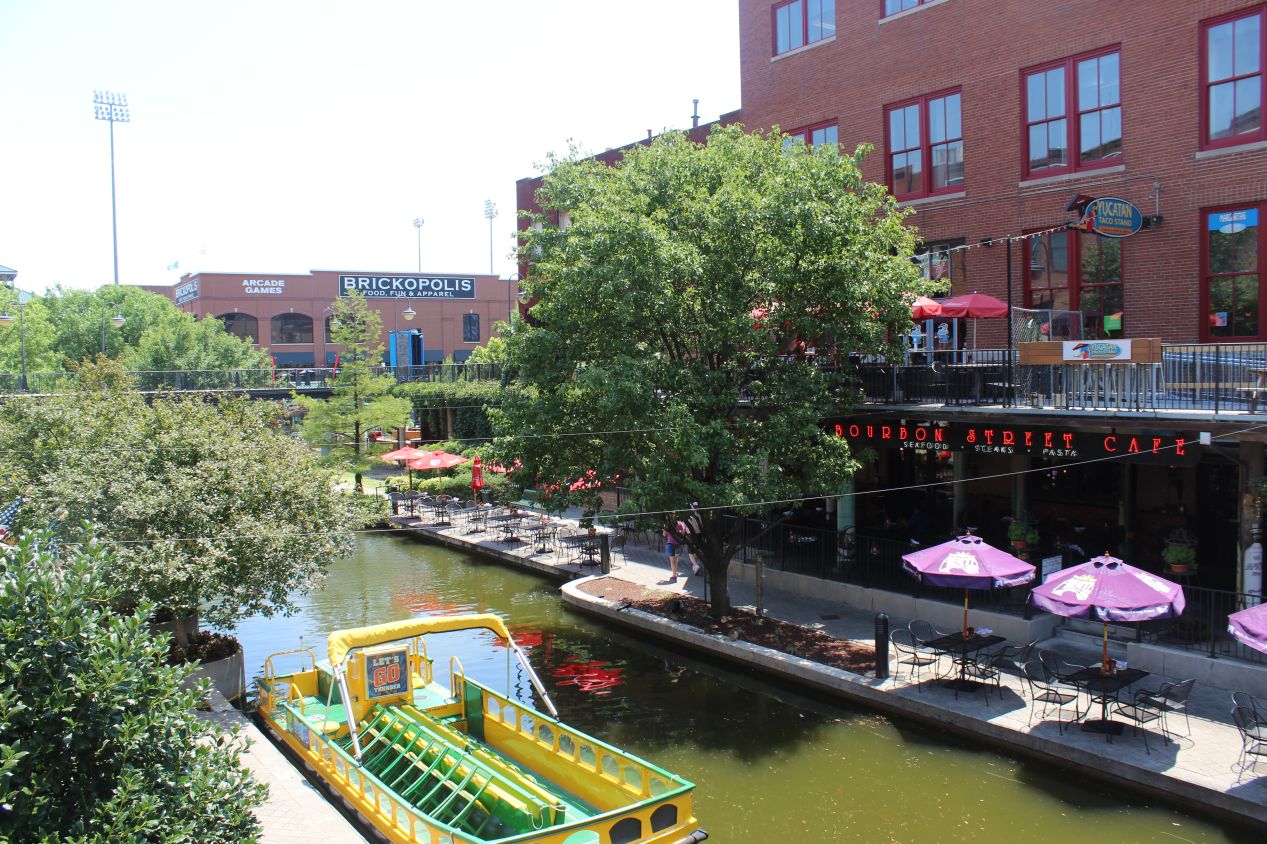


Near the basketball stadium in the downtown was the entrance to Bricktown. This is an entertainment and shopping district based around a canal which was redeveloped by the city in the 1990s. Bricktown was originally a warehousing and shipping district, as it was located close to the Oklahoma River that flows past the city. It fell on hard times in the post-World War II era when many people fled the cities for the suburbs, and the area had collapsed into disrepair by the 1980s. Fortunately, many of the historic brick buildings were able to be saved by the city government, and the whole area was successfully developed into a tourist attraction. Inspiration for Bricktown was drawn from the Riverwalk in San Antonio, and in many ways Bricktown is a shameless recreation of the canal-based shops and restaurants previously pioneered in Oklahoma's southern neighbor. That doesn't change the fact that this is a great place to get a meal or go to enjoy entertainment, and Bricktown is supposed to be the hopping place in Oklahoma City whenever the Thunder are in town for a home game.

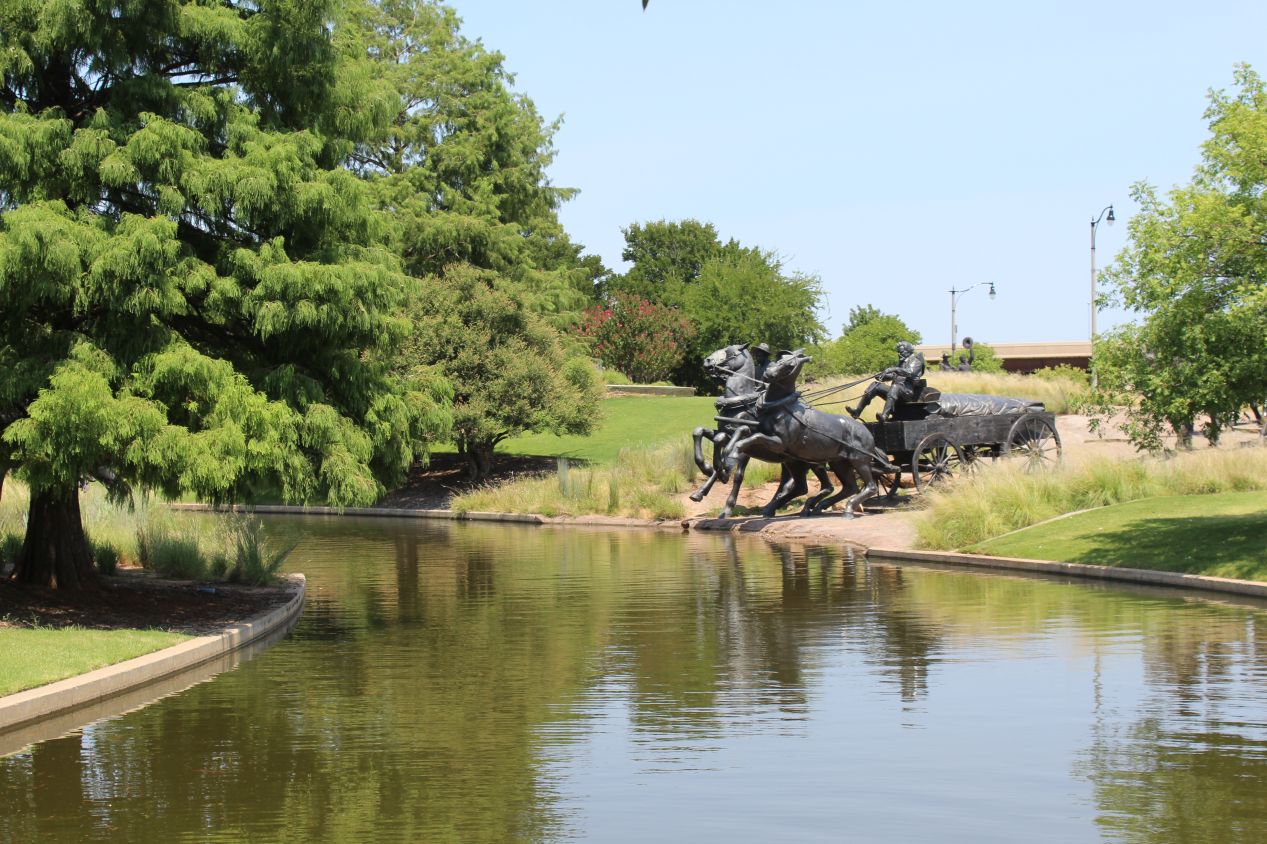


The southern end of the Bricktown canal contains an elaborate sculpture commemorating the Oklahoma Land Run of 1889. It depicts a full wagon train of settlers with life-sized horses and covered wagons, including one of the horses wiping out and falling to the ground. They all look realistic enough to imagine that this is a real moment frozen in time instead of an artist's creative fancy. At the northern end of Bricktown is a completely different attraction in the form of Chickasaw Bricktown Ballpark. This is the home to the AAA affiliate of the Los Angeles Dodgers, and there are a series of statues depicting Warren Spahn, Johnny Bench, and Mickey Mantle outside the stadium. None of them actually played baseball in Oklahoma, but they all had ties to the state through either being born there or living there after retirement. I had been hoping to catch a game at this ballpark only to find that the team was out of town when I visited. I had truly rotten luck when it came to minor league baseball teams on this trip, as every single once that I checked in Indianapolis, Omaha, and Oklahoma City happened to be on the road during my visit.

No, I didn't end up going inside this museum, but I was definitely tempted! 

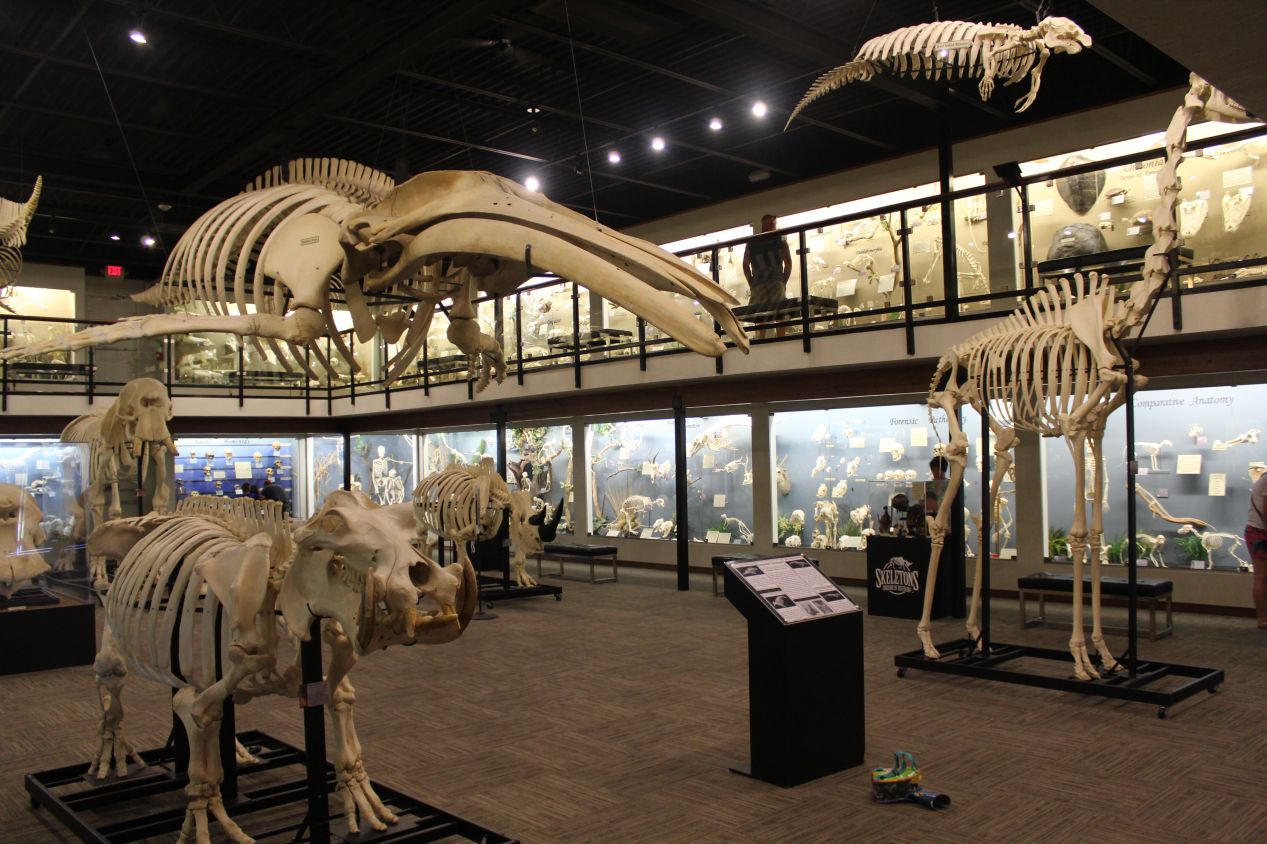


Instead, I drove out of the downtown to visit an equally weird location, this one known as the Museum of Osteology. That fancy name essentially meant that this was a museum of skeletons, the skeletons of all sorts of different creatures from throughout the animal kingdom. While the subject matter was a little bit morbid, this ended up being a pretty cool place to visit simply because there were so many different bones on display. You can really get a good sense for how closely different species are related to one another by seeing their skeletal structures on display side by side. All of these were real skeletons and the museum designers had gone to great pains to label everything with additional information about the specimens that they had collected. For those who aren't squeamish, visitors could also see the process of "cleaning" the bones in action: hundreds of tiny maggots eat all of the flesh off of the animal remains and leave sparkling white bones behind. This apparently works better than even modern power tools at cleaning up the bones. I'll link to a picture of that for the truly curious, but don't say I didn't warn you.

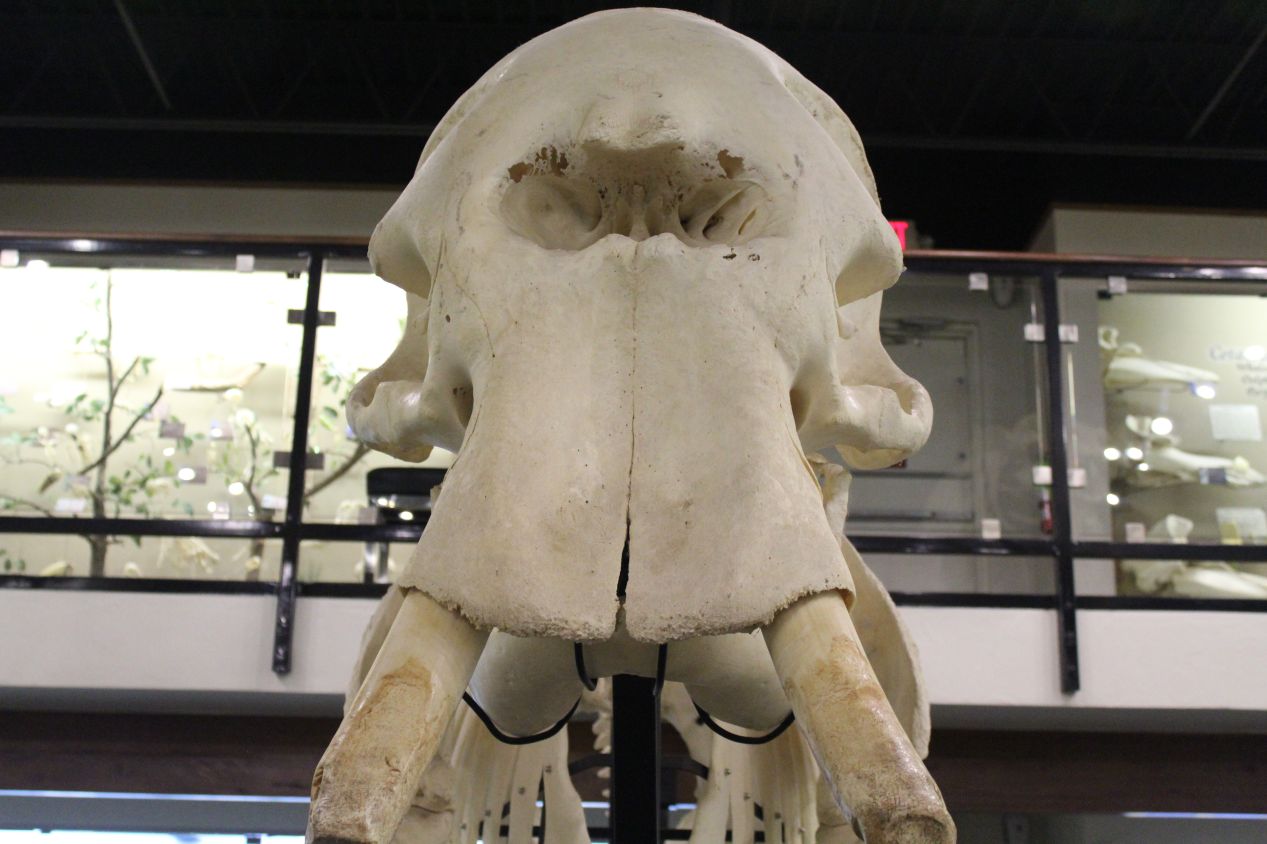


While the Museum of Osteology is fairly small, it does have two floors packed full of different skeletal displays. There are about 7000 total specimens in the museum's collections and 350 of them are on display in the museum at any one time. This place had an elephant, a whale, a giraffe, a hippo, a rhino, and many dozens of smaller animals. The elephant skeleton was particularly interesting; an elephant's skull looks like it has a single huge eye socket, and it's believed that this was the origin of ancient stories about the mythical cyclops. Unlike a lot of the places that I visited on this trip, the Museum of Osteology was fairly crowded for a Thursday afternoon and the kids at the museum really seemed to enjoy it. In a weird way, this is probably a pretty good place to bring younger visitors because there's a lot to see and skeletons that they can touch. Something that's not such a good thing: the museum also sells animal specimens of all different sorts in its gift store. I'm not sure what kind of person wants a preserved skeleton of a squirrel or an owl for their living room, but I probably don't want to hang out with them.
That was the last attraction that I visited in Oklahoma City. I had thought about stopping at the National Cowboy Museum, but ultimately it didn't interest me that much and it was located in the opposite direction on the northern side of the city. The one other place that I would have liked to see was the historic stockyards, which still conduct live cattle auctions but only on Mondays and Tuesdays. It was too bad that I hadn't been in town until the latter half of the week or else I would have stopped to see the cattle being sold. As always, you can't see everything when traveling and have to pick and choose. Next up, I would continue my drive eastwards and spend a day in the Ozarks of northern Arkansas. After a day spent in the city, I was heading back to the countryside once again.



